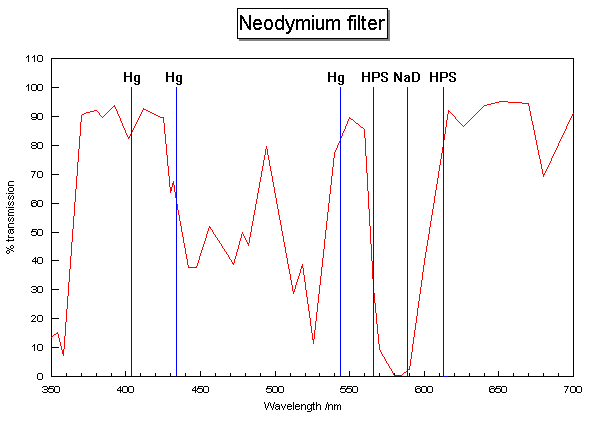
It has long been know in the glass blowing industry that glass doped with certain rare earth salt mixtures has the unusual and useful property of filtering out the bright orange-yellow Sodium D-line emission almost completely.
This type of doped glass is widely used in the glass blowing industry to enable the workers to see into the flame when making intricate designs in sodium borosilicate glass. These glasses give a very high attenuation of the sodium D-line of around a 100000 times. The most commonly available version of this is available as spectacle grade lens blanks using the trade name of Didynium glass filters.
The effect is quite startling as you can stand under a low pressure sodium street lamp and look up at it without seeing any yellow light. You actually see the much fainter red spectral line emissions. This level of filtration is a bit extreme unless you are forced to observe from underneath a suburban streetlamp, and the loss of continuum light is typically 2-3 stops with the dense filter.
The colour of this glass is hard to describe since it appears like the colour minus yellow/orange. Depending on the colour temperature of the incident light it can appear pink, grey or blue-purple. I understand it also has some uses in high quality monitor screens where it is used to improve the colour purity by filtering out unwanted yellow emissions from the red, green and blue phosphors.
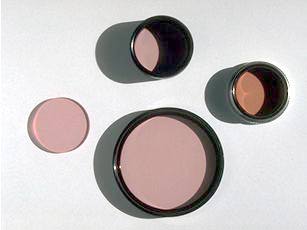
There are also much less strongly doped glasses available which are really
intended as spectroscopic wavelength reference standards. These offer the
advantage of dropping the Sodium D-line intensity by a factor of about 300
whilst only losing about 1/2-1 stop exposure. The effect is less
spectacular on street lamps, for me they seem to lose colour contrast, but
stay bright. However, virtually all reflected sodium light off buildings
and sky will drop below the eye's threshold of visibility.

The above is the typical wavelength response of a 2mm thick NoNaD filter.
My personal favourite is a filter which gives roughly 60% transmission to continuum light and 0.3% transmission near the sodium D-lines. The spectral response is quite serendipitous for astronomy as it also features a peak in transmission near the 500nm range of H-beta and OIII. Note it is completely useless against mercury street lighting. The filter is unusual in that it is a classical doped glass rather than a modern interference bandpass filter.
It is really only any use for sites where the light pollution is predominantly low pressure sodium lighting. It can make a good contribution to improving the visibility of continuum objects if the light pollution is of the right sort. I think it most useful for photographic work near UK cities as it very effectively stops that horrible muddy yellow brown sky colour from sodium street lights.
If you have mostly Sodium lights nearby, then it's certainly worth considering giving the NoNaD filter a try. Interest in these filters is mainly from UK based astrophotographers who have to contend with huge amounts of light pollution. This came as quite a shock to my supplier as they expect to only sell replacements if a laboratory standard gets dropped or broken. They are not multicoated as that is unnecessary for their application as a wavelength standard (and accounts for the peak transmission only reaching 91%).
Prices for mounted polished 2mm thick Nonad glass filters are as
follows:
1.25" eyepiece filter threaded mount - glass 1.1" (27.6mm)
diameter GBP 40
49mm camera lens threaded mount - glass 2" (51mm) diameter GBP 47
They can also be supplied unmounted polished glass and bespoke sizes to
special order. If you want one please drop me a line.
These are small images of Cygnus rising over my northern horizon where the city lights of Middlesborough make the sky very bright. Even on the clearest nights there is very obvious light pollution near the horizon, and the slightest haze over the city makes the sky visibly yellow.
Unfiltered showing strong Na-D light, and after filtering with Neodymium glass
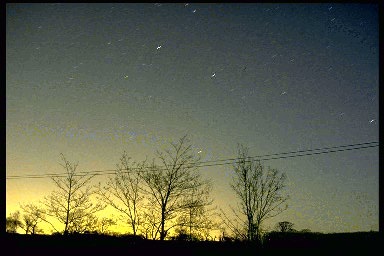

These are consecutive trailed exposures of 2 minutes each taken on Fuji Sensia 100ASA slide film with a Pentax 50mm standard lens at f2.8. The limitations of the digitised image make it a little hard to appreciate how effective this filter is against low pressure sodium lamps. The weaker filter attenuates the yellow sodium D-line by a factor of 300, whilst transmitting most of the continuum (adds about 1/2 a stop to exposures). The reddish colour is from the unattenuated red emission line, and the other pink light of high pressure sodium street lamps which are not so well suppressed.
Here are some photographic pairs of Hale-Bopp from the same light polluted site using exposures of 60 seconds onto Fuji Provia 1600ASA slide film with a Pentax 50mm lens at f2. This film is less sensitive to red but still gives good colour saturation and excellent exposure latitude. This pair of images were taken back to back piggy back guided by an LX200 mounted in altaz mode. Stars near the edge of field show some rotation. These images were taken at 2205 UT on March 30th 1997.
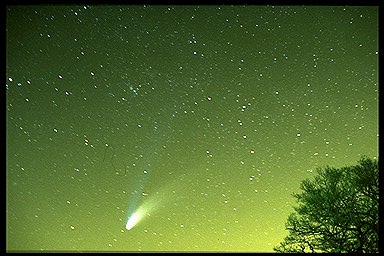
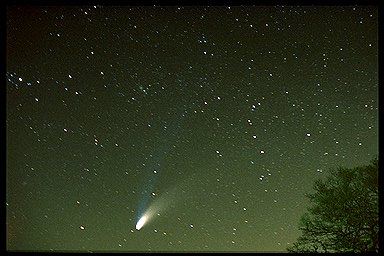
Fuji Provia is less red sensitive than the other emulsion and the Nonad filtered sky is very dark. Some more images of Hale-Bopp unfiltered and filtered in adverse sky conditions with some mist and then through thin cloud are also available. Please see Hale-Bopp filter comparison
I have also taken photographs of the street lamp spectra using different filters to show qualitatively the effects which Nonad, and other light pollution filters have on continuum emission.
The stronger filter (which is too strong for any decent astronomy sites) but may be of interest to city dwellers cuts the D-line by about a factor of 100000. This is sufficient to look up at a street lamp and see no yellow light! Unfortunately, it also loses continuum light equal to more than one stellar magnitude at a dark site.